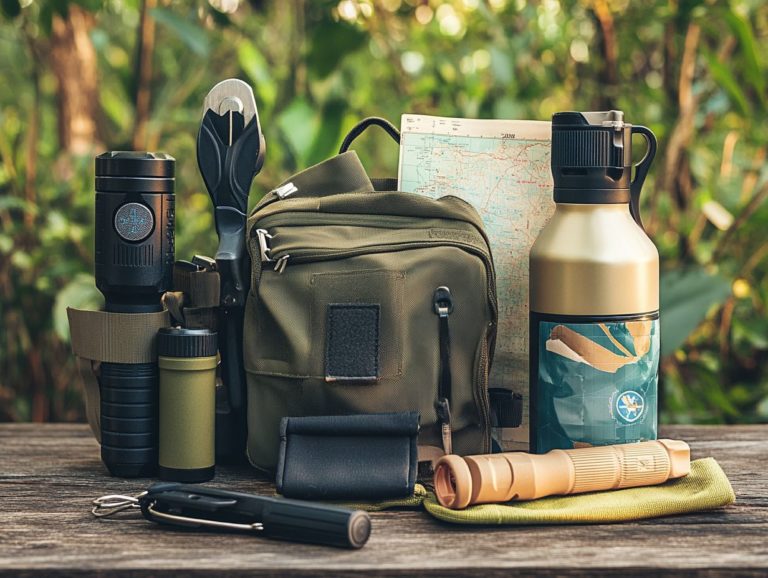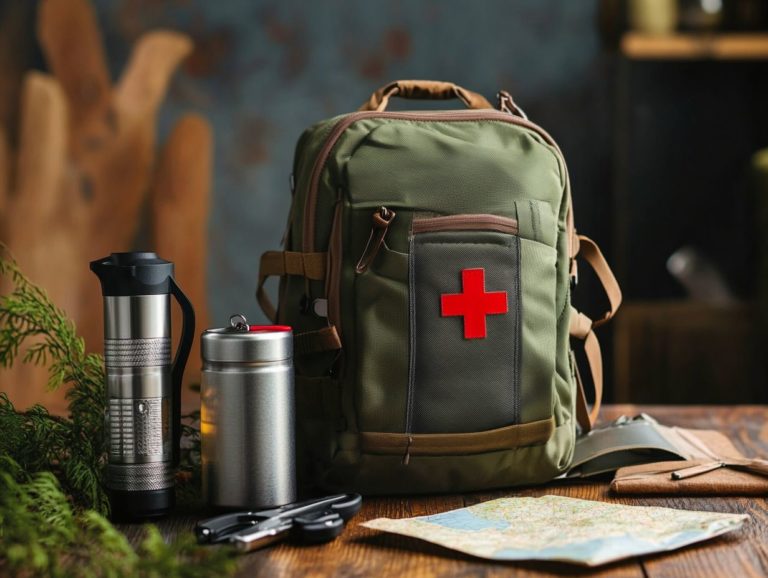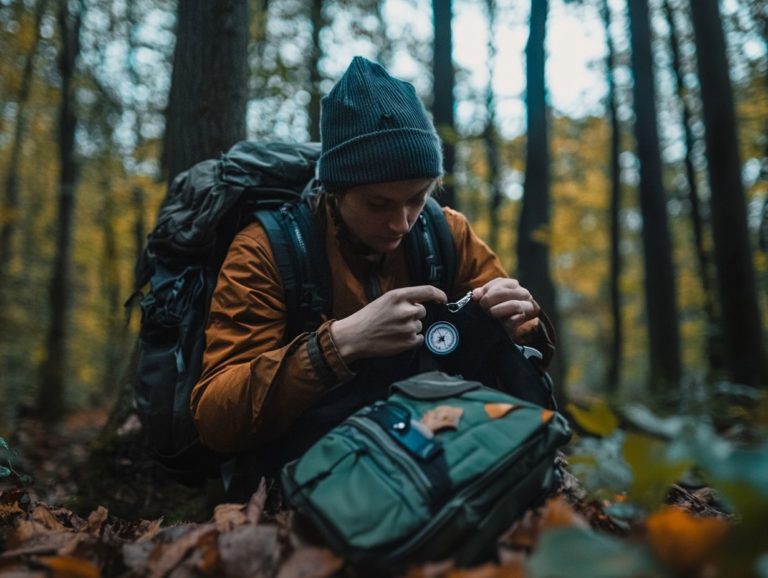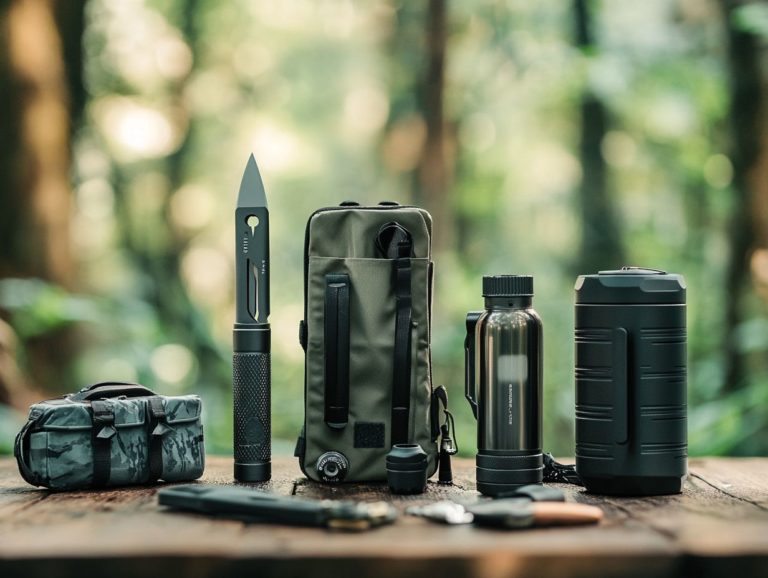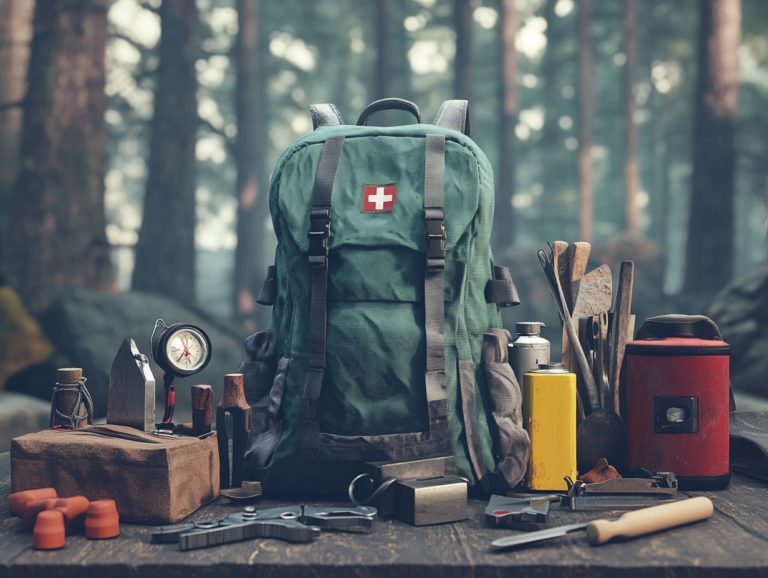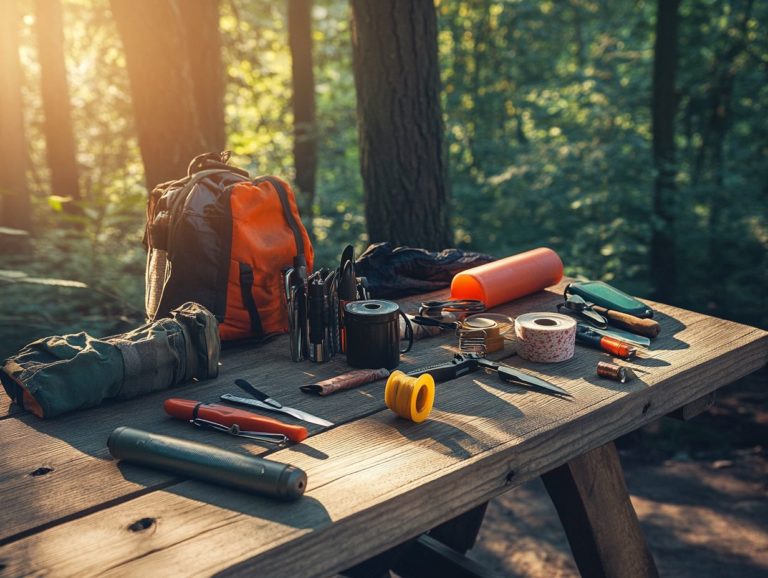5 Essential Tips for Using Survival Gear
When it comes to navigating emergencies, having the right survival gear can truly make all the difference. However, it s not merely about owning the finest equipment; it’s about mastering its effective use.
This article presents five essential tips for you to master your survival gear, guiding you from understanding its intricacies to ensuring it s organized and ready for action at a moment’s notice.
You ll also explore key pieces of gear, common pitfalls to avoid, and the skills that enhance your equipment s utility. Dive in to elevate your preparedness and bolster your confidence in any situation!
Contents
- Key Takeaways:
- 1. Know Your Gear Inside and Out
- 2. Practice Using Your Gear Before an Emergency
- 3. Keep Your Gear Organized and Accessible
- 4. Consider the Weight and Size of Your Gear
- 5. Invest in Quality Gear and Regular Maintenance
- What Are the Most Important Pieces of Survival Gear?
- Frequently Asked Questions
Key Takeaways:
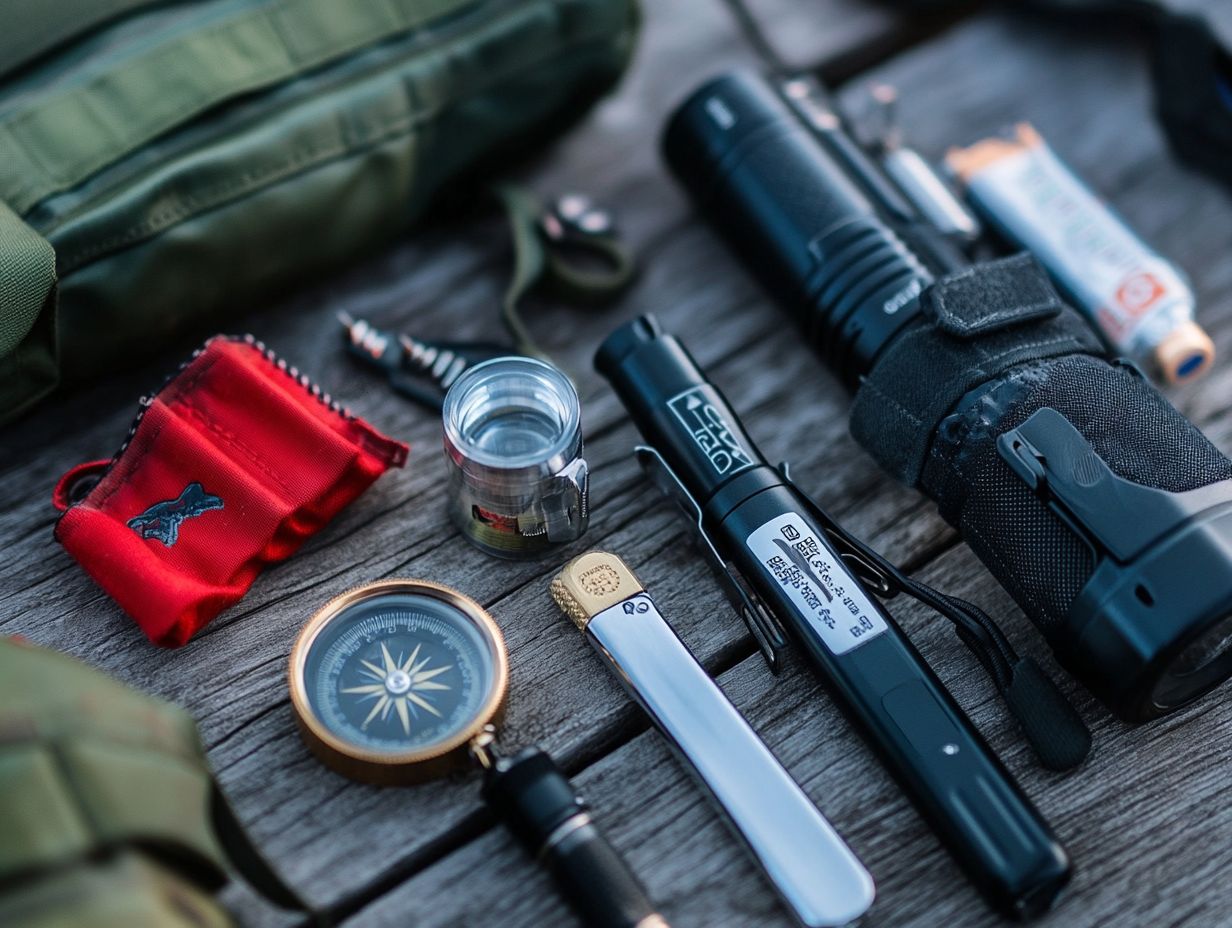
- Familiarize yourself with your survival gear for efficient use in emergencies.
- Regularly practice using your gear to ensure proficiency and confidence during a crisis.
- Keep your gear well-organized and easily accessible for quick and effective use.
1. Know Your Gear Inside and Out
Understanding your gear is essential for mastering outdoor survival, especially in rugged environments like Colorado, where unpredictable weather can push both your skills and your equipment to the limit.
Familiarizing yourself with key survival tools think knives, BIC lighters, ferro rods, and Mylar blankets enables you to make swift decisions that could be the difference between safety and peril on your adventures.
Knowing how to effectively use camping essentials like metal canteens and paracord is crucial for navigating the wilderness and responding to emergencies.
Each tool has a specific purpose that can significantly enhance your safety and effectiveness in the wild. For example, practicing with first aid kits not only builds your competence in treating injuries but also instills a confidence that can prove invaluable in high-stress situations.
Similarly, understanding how to utilize signaling devices, such as whistles or mirrors, can greatly increase your visibility to search and rescue teams during emergencies.
Make it a habit to practice with these essential items whether through mock scenarios or outdoor training to deepen your knowledge and ensure you feel more prepared and less overwhelmed when the unexpected arises during your adventures.
2. Practice Using Your Gear Before an Emergency
Practicing with your gear before an emergency is essential for sharpening your survival skills and ensuring you’re ready for real-life scenarios. This preparation could very well mean the difference between life and death.
Take the time to practice fire-making techniques; it enables you to ignite a flame even in the most challenging conditions. By gathering various local tinder materials and experimenting with different striking methods, you ll gain a deeper understanding of how different environments impact ignitability.
Simulating water purification is another critical practice. Familiarizing yourself with filters or boiling methods can teach you techniques that may prove invaluable when clean drinking water is hard to come by.
You can master navigation tools by engaging in orienteering exercises, where you practice navigating with a map and compass.
By consistently integrating these practices into your outdoor adventures, your preparedness will grow exponentially, ultimately enhancing your ability to manage emergencies with confidence.
3. Keep Your Gear Organized and Accessible
Keeping your survival gear organized and easily accessible is vital for effective outdoor planning and camping safety, enabling you to respond swiftly to emergencies or unexpected situations.
To achieve this, bug out bags become essential. These bags should be thoughtfully packed with prioritized emergency supplies tailored for various scenarios, from first aid kits to food and water purification tools.
Ensuring that the most critical items are placed at the top or in easily reachable compartments allows you to avoid fumbling through layers of gear when every second counts.
Regularly reviewing and updating the contents of these bags is crucial, ensuring your gear remains relevant as seasons change or your personal needs evolve.
Enhanced organization not only maximizes your preparedness but also significantly boosts your overall safety during outdoor adventures.
Get outside, practice your skills, and be ready for anything!
4. Consider the Weight and Size of Your Gear
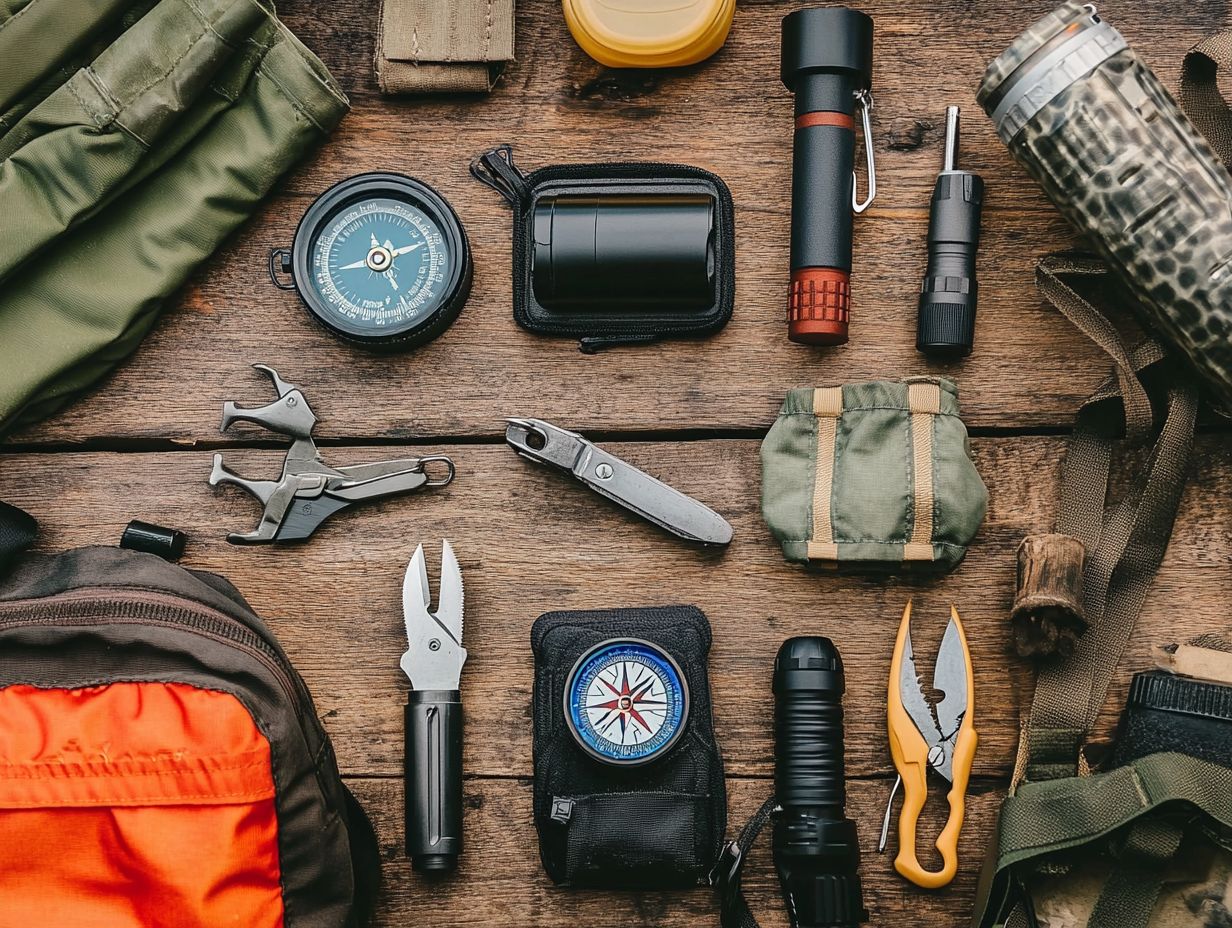
When you set off on outdoor adventures, it s crucial to consider the weight and size of your gear, especially in rugged terrains like Colorado. Every ounce affects your mobility and warmth.
To strike the perfect balance between essential survival gear and a light pack, focus on choosing multifunctional items that prioritize safety. For example, a lightweight tent that sets up quickly offers shelter without draining your energy. Adding compact cookware, versatile clothing layers, and efficient hydration systems can significantly streamline your pack.
Thorough gear preparation enhances your physical performance and builds your mental confidence. This allows you to navigate challenging landscapes with ease. Ultimately, selecting the right lightweight gear can make a real difference, ensuring your outdoor experience is both safe and enjoyable.
5. Invest in Quality Gear and Regular Maintenance
Invest in top-notch survival gear and commit to regular maintenance to greatly enhance your outdoor safety. This ensures your equipment performs well when you need it most.
This is especially true for essential tools like first aid kits, which offer crucial support during emergencies, and fire starters, vital for warmth and cooking. By selecting high-quality products, you guarantee their functionality under pressure while building confidence in unexpected challenges.
Regularly inspect and properly store these tools to protect them from wear and tear, keeping them in top condition for years. Consistent care, like checking expiration dates on medical supplies and keeping fire-starting materials dry, promotes a proactive approach to safety and preparedness.
What Are the Most Important Pieces of Survival Gear?
Identifying the most crucial survival gear is essential for anyone preparing for outdoor adventures. These tools serve as the backbone of effective survival strategies across diverse environments.
Equipping yourself with high-quality first aid kits, reliable fire starters, and effective navigation tools greatly boosts your chances of thriving in challenging scenarios. A robust first aid kit allows you to address injuries promptly, preventing minor issues from escalating. Fire starters provide warmth and enable cooking and purifying water vital for your health and hydration.
Navigation tools, such as compasses and maps, aid self-orientation, guiding you to water sources and helping you find areas with edible plants. This knowledge enhances your overall wilderness survival skills, ensuring a safer and more enjoyable experience as you explore.
How Can Survival Gear Help in Different Emergency Situations?
Survival gear is essential in various emergency situations, providing tools and supplies that significantly improve your chances of staying safe and thriving in the wilderness.
Whether you find yourself lost in an unfamiliar forest, facing potential wildlife encounters, or needing an emergency shelter due to sudden bad weather, having the right survival gear is absolutely essential.
Imagine the uncertainty of wandering off the beaten path without a proper map or compass; without these crucial instruments, the risk of disorientation increases dramatically.
Your outdoor skills, such as foraging for food and starting a fire, become essential for your well-being in challenging conditions. It’s vital to understand how to use your gear effectively; this not only enhances your chances of survival but also boosts your confidence, transforming any outdoor adventure into a more enjoyable experience.
Ready to gear up for your next adventure? Check out our full guide on essential survival tools!
What Are the Most Common Mistakes When Using Survival Gear?
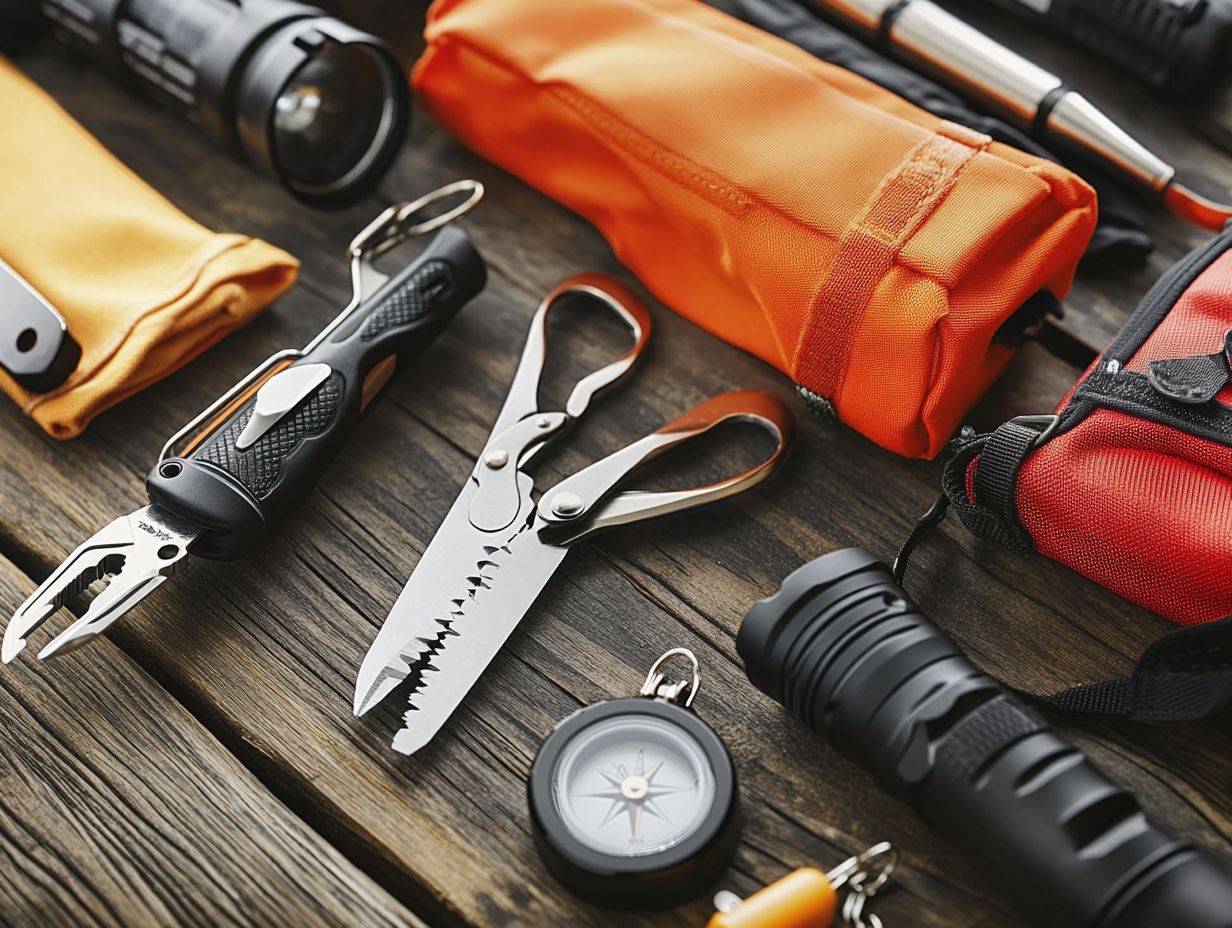
Understanding the most common mistakes made with survival gear can greatly enhance your outdoor skills and improve your safety in emergency situations.
Many adventurers often overlook the necessity of fully familiarizing themselves with their equipment before heading out on a trip. For example, using camping stoves incorrectly or failing to practice setting up a tent under various weather conditions can lead to serious issues.
Regular maintenance is frequently neglected. Checking for leaks in gas canisters or ensuring that your knives are sharp can be the difference between success and failure when you need your gear the most.
To sidestep these pitfalls, conduct dry runs in controlled environments. Establish a maintenance schedule. Conducting dry runs can be a game-changer! It boosts your confidence and sharpens your skills.
How Can One Customize Their Gear to Fit Their Needs?
Customizing your survival gear to meet your personal needs is essential for being fully prepared for outdoor adventures and any potential emergencies.
Consider factors such as climate, terrain, and the specific activities you have in mind. You can assemble an emergency kit that truly reflects your unique skill set and preferences. If winter camping is your thing, prioritize insulated clothing and a reliable heating source.
On the other hand, if you re tackling rocky trails, easy-to-carry tools and durable footwear will be your best friends.
Taking the time to evaluate your comfort levels with various outdoor scenarios can guide your choices for food supplies, navigation tools, and water purification methods. This ensures your gear is perfectly aligned with your individual survival strategies.
What Are the Best Ways to Carry and Store Survival Gear?
Carrying and storing your survival gear effectively is essential for outdoor planning, ensuring that all necessary items are readily accessible in emergencies.
By employing specialized backpacks, vests, and other innovative storage solutions, you can significantly enhance your preparedness. These options improve weight distribution and provide easy access, which is vital when every second counts.
Organizing your gear efficiently whether by category or frequency of use can streamline retrieval during critical moments.
Consider the specific outdoor conditions, such as weather and terrain. This allows you to choose gear that is both lightweight and durable. This ensures you re equipped for any challenge while maintaining comfort and mobility.
What Are Some Essential Skills to Have Alongside Survival Gear?
Plus packing your survival gear, developing essential survival skills is vital for navigating the challenges of the wilderness and ensuring your personal safety during outdoor adventures.
Learn navigation techniques; they can dramatically enhance your ability to find your way in unfamiliar terrain, especially when relying solely on a compass or map becomes impractical.
Learn first aid techniques; they can save lives when help is far away. Master fire-making skills! They provide warmth, cooking options, and a way to signal for help.
Being aware of local wildlife and learning how to coexist with it can help you avoid dangerous encounters. This ensures that your gear and skills work together seamlessly to elevate your overall survival strategy.
Frequently Asked Questions
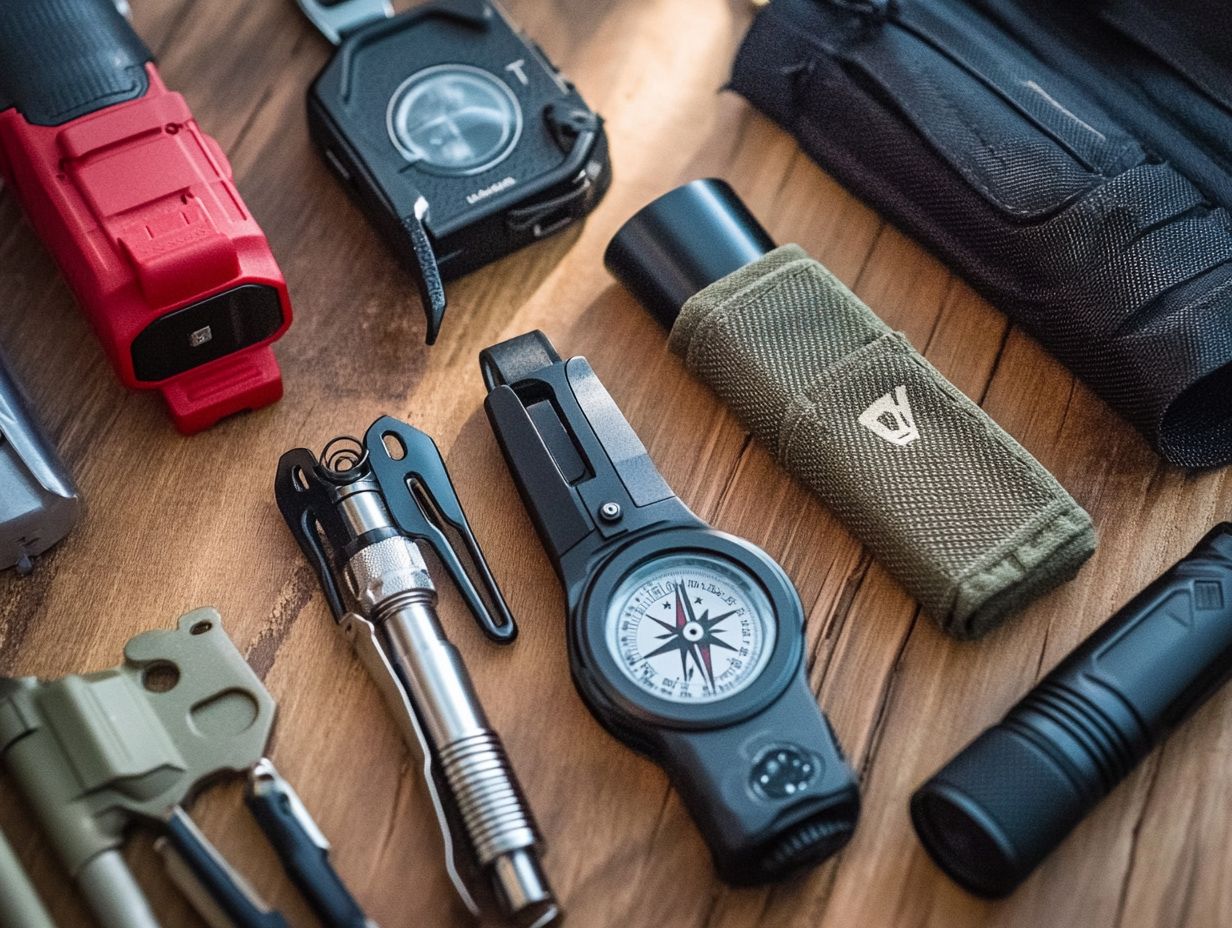
What are the 5 essential tips for using survival gear?
Got questions about survival gear? Here are five essential tips to get you started!
- Choose gear based on the environment you’ll be in.
- Pack lightweight and multi-purpose items.
- Learn how to use your gear before an emergency.
- Regularly check and maintain your gear.
- Practice using your gear in real-life scenarios.
Ready to gear up for your next adventure? Start preparing today!
Why Choose Gear for Your Environment?
Your safety depends on the right gear for the environment. Cold and snowy places need warm gear to protect you from harsh conditions.
What Are Lightweight, Multi-Purpose Items?
Selecting lightweight gear that serves many functions is key. This choice lightens your load and frees up space for essentials.
Why Learn to Use Your Gear Before an Emergency?
Getting to know your gear helps you use it efficiently. This knowledge saves time and reduces panic during real emergencies.
When to Check and Maintain Your Gear?
Regular checks keep your gear in top shape. Inspect it before and after each use, and perform maintenance at least once a year.
Why Practice with Your Gear?
Practicing with your gear makes you comfortable and confident. Regular use reveals potential issues so you can fix them before an emergency.

